The flights of the 1902 glider had demonstrated the efficiency of' our system for maintaining equilibrium, and also the accuracy of' the laboratory work upon which the design of the glider was based. We then felt that we were prepared to calculate in advance the performance of machines with a degree of accuracy that had never been possible with the data and tables possessed by our predecessors. Before leaving camp in 1902 we were already at work on the general design of a new machine which we proposed to propel with a motor.
Immediately upon our return to Dayton, we wrote to a number of automobile and motor builders, stating the purpose for which we desired a motor, and asking whether they could furnish one that would develop eight-brake horse power, with a weight complete not exceeding 200 pounds. Most of the companies answered that they were too busy with their regular business to undertake the building of' such a motor for us; but one company replied that they had motors rated at 8 h.p. according to the French system of ratings, which weighed only 135 pounds, and that if we thought this motor would develop enough power for our purpose, they would be glad to sell us one.
After an examination of the particulars of this motor, from which we learned that it had but a single cylinder of' 4 inch bore and 5 inch stroke, we were afraid that it was much overrated. Unless the motor would develop a full 8 brake horse power, it would be useless for our purpose.

